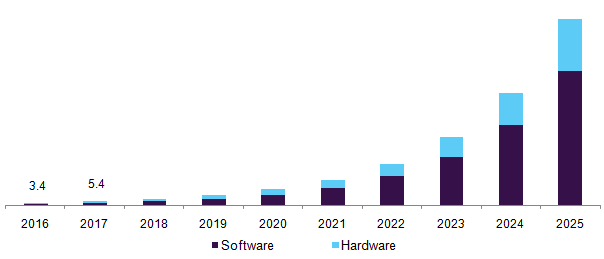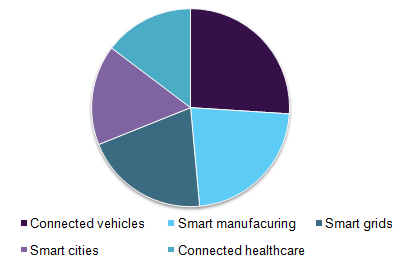- Home
- »
- Communications Infrastructure
- »
-
Fog Computing Market Size, Share, Global Industry Trend Report, 2025GVR Report cover
![Fog Computing Market Size, Share & Trends Report]()
Fog Computing Market Size, Share & Trends Analysis Report By Solution, By Hardware (Gateways, Routers & Switches, Sensors), By Application (Connected Vehicles, Smart Grids, Smart Cities, Connected Healthcare), By Region, & Segment Forecasts, 2018 - 2025
- Report ID: GVR-2-68038-838-1
- Number of Report Pages: 100
- Format: PDF, Horizon Databook
- Historical Range: 2017 - 2025
- Forecast Period: 2017 - 2025
- Industry: Technology
Industry Insights
The global fog computing market size was estimated at USD 9.33 million in 2016. The increasing adoption of smart devices and the need for addressing challenges associated with mobile traffic is driving the industry growth.
Fog extends the cloud capabilities by offering a unified solution and virtualized resources to the edge of the network. The increasing penetration of Internet of Things (IoT) and cloud services is expected positively impact the industry growth over the next nine years. Additionally, the key driving factors boosting the growth of software and devices include the growing need for real-time interaction with incoming data and the limitations of bandwidth availability.
U.S. fog computing market, by solution, 2016 - 2025 (USD Million)

There has been a significant transition from cloud to fog, as the latter offers low latency and widespread geographic distribution along with less probability of cyber-attack on data enrouter. Moreover, the evolution of 5G technology has led to the emergence of an edge computing data architecture with low latency issues and bandwidth bottleneck elimination. Additionally, the evolution of IoT into Internet of Everything (IoE) requires high-speed data analytics and shorter response time. The decentralized architecture overcomes these challenges by bringing the endpoint devices closer to the cloud.
Organizations using fog computing have witnessed an improvement in their productivity by moving their computation to the nodes, offering significant business benefits and insights. This architecture filters the voluminous data and pushes only relevant data to the cloud, thereby supporting actionable analytics and real-time capabilities. Moreover, these technologies are aiding organizations in overcoming the challenges of centralized data processing.
Solution Insights
The hardware segment captured a revenue share of over 35% in 2016. The declining component costs and advancements in the functionality of the devices are expected to contribute to the growth of the hardware segment over the next nine years. Furthermore, the decreasing cost of sensors and data storage devices, together with the ubiquity of wireless networks, are speeding the proliferation of fog nodes.
Cellular and network communications are witnessing continuous price reductions that support the connectivity of IoT devices. With the increasing demand for IoT devices, the prices for utilizing 3G and 4G networks are expected to decline further, thereby driving reductions in the recurring operational expenses for organizations.
The software segment contributed significantly to the industry growth in 2016. The growth can be attributed to the increasing penetration of Software as a Service (SaaS) cloud framework. Moreover, the capability of the software to address the broad business functions, including collaboration, analytics, and e-commerce, is expected to impact the growth positively over the forecast period.
Hardware Insights
The sensors segment accounted for over 30% revenue share in 2016. As the demand for low latency and decentralized platforms is gaining prominence, there is a growing trend toward distributed data storage and processing approach. This has led to the increased demand for smart sensors and wireless sensor network architectures for processing data.
System integrators and solution providers are relying on MEMS sensors due to increased level of digital integration and the compact size of these sensors. Additionally, hardware manufacturers are collaborating with machine learning and IoT vendors to deliver routers and gateways that support fog computing. Furthermore, analytics software companies are focusing on scaling their products for developing new tools for edge computing applications.
The gateways segment contributed significantly to the industry growth in 2016 due to the need for preprocessing data that is sent to the cloud. These gateways strengthen the infrastructure by processing the data, which enables the solutions to meet the requirements of low latency responses.
Application Insights
The connected vehicles segment captured a revenue share of over 25% in 2016 as it provides real-time analytics and informed decisions on driving patterns. Moreover, fog computing reduces the transfer of large data of video and audio recordings generated by video and dashboard cameras. The need for streamlining traffic and effective transportation management is aiding the industry growth by enhancing the connectivity of transport systems.
Global fog computing market, by application, 2016 (%)

The technology integrates traffic information with connected vehicles and aids drivers in avoiding distractions by providing real-time decisions and analytics on the driving patterns. Moreover, it provides accident and traffic information to the concerned authorities to respond to emergencies more quickly. The usage of such systems maximizes efficiency in traffic management and shortens the travel duration.
The connected healthcare segment captured a revenue share of close to 15% in 2016. Fog streamlines the healthcare cloud to offer users better control over data storage and access to the necessary information. As healthcare organizations are increasingly deploying IoT technologies to their infrastructure, there has been a need for ensuring a smarter communication network. It provides a communicating environment that enables devices to access the required information through a cloud network.
Regional Insights
North America dominated the fog computing market in 2016. Key factors driving the regional growth include the high adoption of IoT and increasing investment in ongoing research on the development of fog architecture. For instance, in the U.S., a project has been initiated which enables the traffic lights to integrate with connected vehicles to reduce the travel time. Moreover, the presence of several players in the region is expected to lead to the early adoption of the technology.
The Asia Pacific region accounted for a revenue share of over 15% in 2016. The need for leveraging the advantage of hybrid IT environments to deliver flexibility and agility is driving the industry growth. Additionally, the region has witnessed a high adoption of cloud services in key economies of China, Japan, and Australia, thereby providing growth avenues for the implementation of fog network. Moreover, the Indian Government’s Make in India campaign is expected to boost the smart manufacturing growth, thereby propelling the demand for streaming data from the cloud and back.
The technology is gaining prominence in Japan as the OpenFog Consortium has signed a liaison with IoT Acceleration Consortium (ITAC) to collaborate and test the standards and developments. Moreover, the growth of connected cars in the country is expected to increase the need for efficient data handling and communication platform.
Fog Computing Market Share Insight
The key players in the industry include Cisco Systems, Inc., Nebbiolo Technologies, PrismTech, and FogHorn Systems. Companies are engaging in partnerships and collaborations to develop effective solutions in the fog and edge landscape. For instance, in June 2016, IBM Corporation and Cisco Systems, Inc. announced a partnership to integrate Watson’s IoT cloud software with Cisco’s new fog computing platform.
In the past three years, several companies have shifted their focus towards providing comprehensive fog computing solutions apart from their core business processes. In October 2015, Dell announced the launch of its Edge Gateway 5000 series to provide an edge computing solution in building and factory automation sectors.
Report Scope
Attribute
Details
Base year for estimation
2016
Forecast period
2017 - 2025
Market representation
Revenue in USD Thousand & CAGR from 2017 to 2025
Regional scope
North America, EMEA, Asia Pacific, and Latin America
Country scope
U.S., Canada, UK, Germany, MEA, China, Japan, Brazil, and Mexico
Report coverage
Revenue forecast, company share, competitive landscape, growth factors, and trends
15% free customization scope (equivalent to five analyst working days)
If you need specific market information that is not currently within the scope of the report, we will provide it to you as a part of the customization
Segments Covered in the ReportThis report forecasts revenue growths at global, regional, and country levels and provides an analysis of the industry trends in each of the sub-segments from 2016 to 2025. For the purpose of this study, Grand View Research has segmented the global fog computing market based on solution, hardware, application, and region.
-
Solution Outlook (Revenue, USD Thousand; 2016 - 2025)
-
Hardware
-
Software
-
-
Hardware Outlook (Revenue, USD Thousand; 2016 - 2025)
-
Gateways
-
Routers & switches
-
IP video cameras
-
Sensors
-
Micro data center
-
-
Application Outlook (Revenue, USD Thousand; 2016 - 2025)
-
Connected vehicles
-
Smart grids
-
Smart cities
-
Connected healthcare
-
Smart manufacturing
-
-
Regional Outlook (Revenue, USD Thousand; 2016 - 2025)
-
North America
-
U.S.
-
Canada
-
-
EMEA
-
Germany
-
UK
-
MEA
-
-
Asia Pacific
-
China
-
Japan
-
-
Latin America
-
Brazil
-
Mexico
-
-
Share this report with your colleague or friend.
![gvr icn]()
NEED A CUSTOM REPORT?
We can customize every report - free of charge - including purchasing stand-alone sections or country-level reports, as well as offer affordable discounts for start-ups & universities. Contact us now
![Certified Icon]()
We are GDPR and CCPA compliant! Your transaction & personal information is safe and secure. For more details, please read our privacy policy.
We are committed towards customer satisfaction, and quality service.
"The quality of research they have done for us has been excellent."





